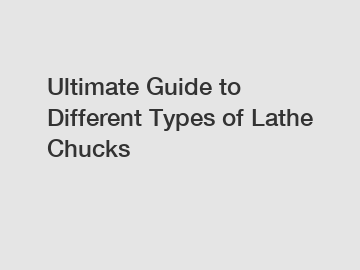Mar. 11, 2024
Hardware
qz3qz3-front-load-pneumatic-chuck2.html" style="color:#0782C1">DRAKE are exported all over the world and different industries with quality first. Our belief is to provide our customers with more and better high value-added products. Let's create a better future together.
The ultimate guide to different types of lathe chucks.
A lathe chuck is a crucial component of a lathe machine, used to hold and rotate the workpiece during machining operations. There are several types of lathe chucks available, each designed for specific applications and requirements. In this article, we will discuss the different types of lathe chucks, their features, and the applications they are best suited for.

1. Three-Jaw Self-Centering Chuck.
The three-jaw self-centering chuck is the most commonly used type of lathe chuck. It is designed to automatically center the workpiece, making it easy to use and highly efficient. The three jaws of this chuck move in tandem, ensuring that the workpiece is accurately centered and secured during machining operations. This type of chuck is ideal for holding cylindrical workpieces with a high degree of precision.
2. Four-Jaw Independent Chuck.
The four-jaw independent chuck allows for more flexibility and precision in holding irregularly shaped or non-symmetrical workpieces. Each jaw of the chuck can be adjusted independently, allowing the operator to center and secure the workpiece accurately. This type of chuck is commonly used for holding square, hexagonal, or octagonal workpieces that cannot be securely held by a three-jaw chuck.
3. Collet Chuck.
A collet chuck is specifically designed for holding small, cylindrical workpieces with high precision and repeatability. The collet chuck features a collet that securely grips the workpiece, ensuring optimal concentricity and accuracy during machining operations. This type of chuck is commonly used in high-speed machining applications where precision and repeatability are critical.
4. Faceplate Chuck.
A faceplate chuck is a larger chuck designed for holding big and heavy workpieces that cannot be accommodated by other types of chucks. The faceplate chuck features a flat plate with T-slots or radial slots that allow for secure clamping of the workpiece. This type of chuck is commonly used in heavy-duty machining applications such as turning large diameter workpieces or holding irregularly shaped workpieces.
In conclusion, the choice of lathe chuck plays a crucial role in the success of machining operations. By understanding the different types of lathe chucks available and their features, operators can select the most suitable chuck for their specific application requirements. Whether it's a three-jaw self-centering chuck for cylindrical workpieces or a collet chuck for small, precision workpieces, choosing the right chuck can improve machining efficiency and accuracy. Ultimately, a well-selected lathe chuck can lead to higher productivity, better quality parts, and reduced production costs.
For more information, please visit our website.
If you are interested in sending in a Guest Blogger Submission,welcome to write for us!
All Comments ( 0 )